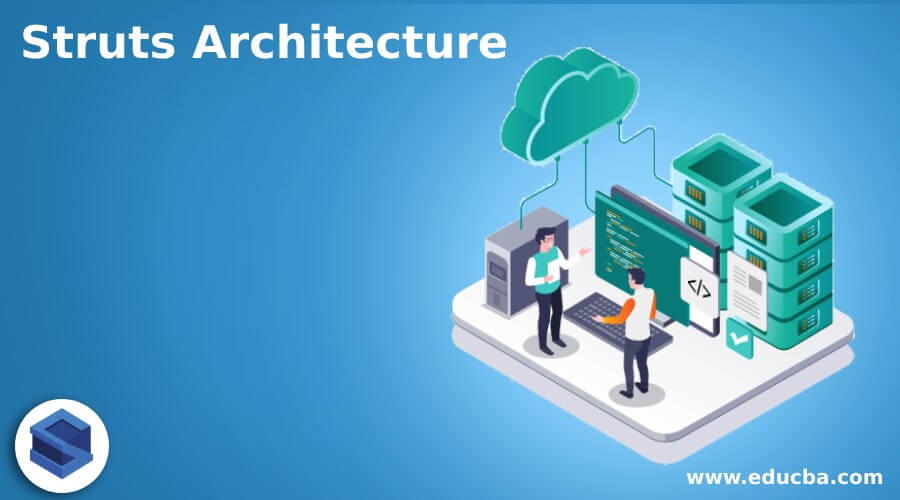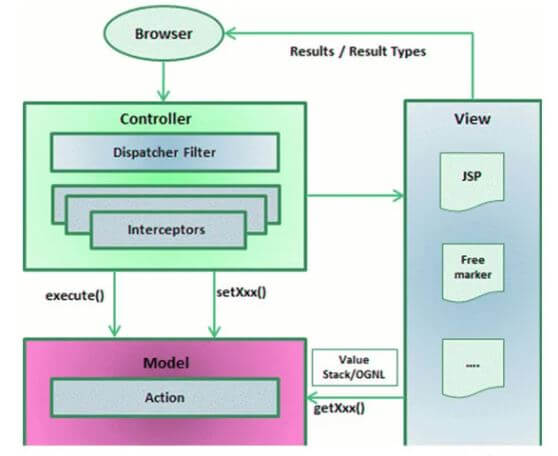Updated June 2, 2023
Introduction to Struts Architecture
Struts architecture is made up by using the most popular concept in java applications which is MVC. MVC pattern is followed by struts which stands for Model View Controller that is essentially used when you want to bring the separation in your application between the application data, business logic and the way in which all this is presented to the user. The main advantage of having MVC architecture for structs is that the application becomes reusable and expressive. In case, if any sort of change is to be made when the problem occurs, we don’t need to write the code solution from scratch. We can simply learn the pattern and modify it as per necessity.
Here we will see the MVC pattern followed by struts architecture and also see about various other components that form the architecture of struts.
Model View Controller
Before we see the components and architecture diagram of struts let us first see the conceptual base on which the architecture of struts is created that is the MVC pattern.
- Model: The model includes the business logic of the code where the operations related to data such as access to the data, validating the same and the way in which the data is to be saved in data stores or database is included as the responsibility of Model part. Before the data is sent to the database for saving, it is verified by the views present and if the structure of the data is proper then only it is further sent to the database for inserting the record or doing any other sort of manipulations.
- View: This part is responsible for all the things that the user will be able to view and also it will take all the required inputs from the user, generating the request that should be passed to the controller for handling and also accept the responses that are in turn sent by the controller which can be further displayed on screen for the users. When using sprites, we can make the use of custom tag libraries, HTML, resources file and HTML when using the View component of the MVC structure.
- Controller: This component acts as the median between the other two components that is View and Model. It is responsible for managing and handling all the requests that are received by it from the view side that is user. As soon as the request arrives, a certain business logic code is executed by the controller which handles the model structure and after executing returns the proper data in the form of a model to the view. The parts included in the controller are struts-config.xml, ActionForm and ActionServlet.
Architecture of Struts
The diagram that will help us to demonstrate the architecture of struts is given below. Let us now see different components of structs architecture and how the flow works.
We can clearly observe the three broad components of the strut’s architecture are Model, View and controller that form the high-level struts architecture. When they are further digging to get the details, we get a clearer view. Interceptors and dispatch servlet filters together try to implement the controller in struts. The model component is carried out by using the actions. The third component that is view is generated by combining results and the type of results. The integration between view and controller and view and model is enabled by using OGNL and value stack which act as a linking and common thread.
Other than the components mentioned in the above diagram, struts architecture includes a lot of configuration related details that include the configuration for results, interceptors, actions, the web application and many other components details.
The life cycle of the request done by the user can be understood by studying the workflow of structs which can be derived from the above architecture diagram.
- The required resource is taken by the view and the user(client) further makes the request to the server in case of client-server architecture which contains the specification of the required resource.
- Proper action is taken after the filter dispatcher studies the request and decides the action to be taken.
- The functionalities related to interceptors that are configured such as file upload of validation are carried out.
- The action that is decided and selected after this is executed depending on the type of operation requested in the client request.
- If any sort of post-processing is required then the application of configured interceptors is carried out again.
- The last step includes the creation of the result by the view and returning the same as the response to the user (client).
Contents of MVC Struts Architecture
The MVC pattern followed by struts generally make the use of the following technologies in each of its components:
- Model: Form implementing the business logic, we make the use of Java Beans mostly.
- View: As a layer of presentation, we can make the use of Java server pages of Angular JS or any client-side technology for handling the user experience and user interface.
- Controller: Most of the time, the use of servlet is made as a controller which includes different action classes that can control security, handling of the session and primary logic related to actions.
All these three components work together to make up and execute the request-response flow in a timely manner with accuracy to the user which adds up to a great user experience. The most prominent feature of model view controller is that due to this separate logical distribution of code, it becomes very much easy to decode, manage and add any additional feature to your application.
Conclusion
The struts architecture is made up of different components and broadly we can segregate them into three types is Model, View and Controller. The MVC pattern followed by struts architecture is very popular among developers as it brings along with it great advantages for use.
Recommended Articles
This is a guide to Struts Architecture. Here we discuss the introduction, model view controller and contents of MVC struts architecture. You may also have a look at the following articles to learn more –



